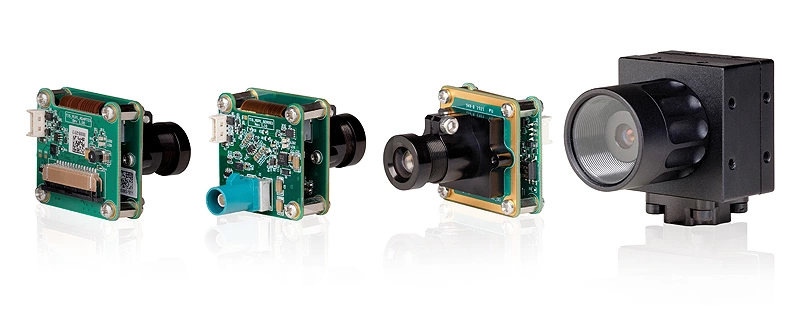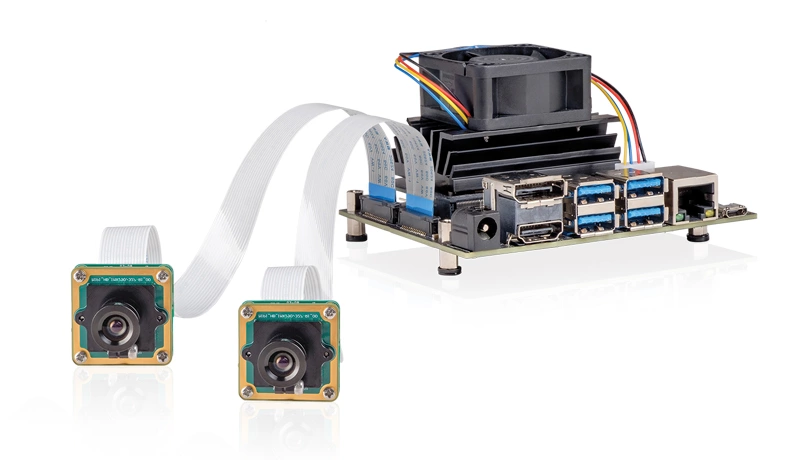Expanded Embedded Vision Product Line
Published on August 28, 2020 by TIS Marketing.
In order to efficiently access the performance features of the NVIDIA and Raspberry Pi 4 platforms for embedded vision applications, The Imaging Source offers a portfolio of MIPI CSI-2 board cameras. Many embedded machine vision applications (especially multi-camera applications) require cable lengths longer than the maximum 20 cm reached with MIPI CSI-2 cameras. Using the FPD-Link III bridge, cable lengths of up to 15m can be achieved. Image data is transmitted via a thin (Ø 2.8 mm) coaxial cable at up to 4.16 Gbps, with image data, control commands and power supply being transmitted simultaneously. The bandwidth is sufficient, for example, for the transfer of image data from a 5-MP camera at 30 frames/s. Developers can choose between MIPI-CSI-2 and FPD-Link-III board cameras as well as FPD-Link-III cameras with IP67-rated housing. The compact cameras are available as monochrome and color versions with the latest CMOS image sensors from Sony and On Semiconductor (global shutter and rolling shutter with resolutions from 0.3 MP [VGA] - 8.3 MP).

Why Choose MIPI CSI-2 or FPD-Link-III Camera Interfaces?
The Imaging Source provides MIPI CSI-2 and FPD-Link-III camera carrier boards with up to 6 camera inputs (platform dependent) for connecting the board cameras to the NVIDIA® Jetson Nano™, NVIDIA® Jetson Xavier™ NX, NVIDIA® Jetson AGX Xavier™ and Raspberry Pi 4. Some users might be left wondering what the reasons are for using MIPI CSI-2 or FPD-Link-III cameras instead of USB-3 or GigE cameras. The answer lies in the hardware features of the embedded platforms themselves, namely the hardware-accelerated image signal processor (ISP). The embedded platforms' MIPI-CSI-2 interfaces are directly connected to the ISP to avoid latencies and data conversions. The Imaging Source's MIPI-CSI-2 cameras have been specifically designed to pass the raw image data directly to the interface. Since these embedded board cameras include only essential functionality, they are particularly cost effective. The ISP handles hardware-accelerated operations such as de-bayering, color correction, color space conversion, white balance, lens correction and image data compression (e.g. H.264/H.256).

Platforms Bring the Power of AI to Embedded Vision
In addition to their ISPs, the aforementioned embedded computers from NVIDIA (e.g. NVIDIA Jetson Nano, Xavier NX* and AGX Xavier*) offer a GPU with CUDA cores and several MIPI-CSI-2 camera interfaces which make them predestined for AI and demanding machine vision applications. The NVIDIA platforms are capable of running several neural networks in parallel to implement image segmentation, image classification and object recognition. The NVIDIA SDK "JetPack" supports all NVIDIA Jetson-based embedded platforms.

NVIDIA offers extensive software libraries for deep learning and for image and video processing. The Imaging Source provides the corresponding camera drivers, which are seamlessly integrated into the NVIDIA software framework. This allows image data to be transferred directly to a pre-trained deep learning module.
For less demanding image processing tasks, the Raspberry Pi 4 with a MIPI-CSI-2 camera interface and an ISP is also an excellent choice. Here too, the MIPI-CSI-2 interface is directly connected to the ISP. The Raspberry Pi 4, for example, is capable of compressing high-resolution H.264 images and sending them via Ethernet or WLAN.
The NVIDIA and Raspberry Pi embedded platforms are supported by a large open source and maker communities. Support questions can be posted in appropriate forums, where developers can exchange information with each other. NVIDIA also offers free online training courses on the subject of deep learning.
*The Imaging Source's latest embedded products for NVIDIA's Xavier NX and AGX Xavier platforms will be available in Q1 2021. Please contact us if you would like to be informed as the products become available.
The above article was published in the September 2020 edition of the German-language industry journal Markt&Technik under the title, FPD-Link III ergänzt MIPI CSI-2.
